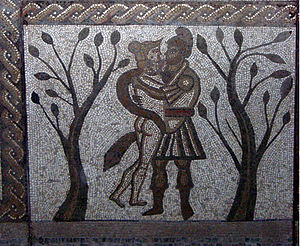
The beauty of some stories is that they are telling one story when they seem to be really telling another.
Take the Aeneid for example. Virgil wrote the Aeneid c. 29-19 BCE – in other words over two thousand years ago. He wrote it to glorify Rome and to give the Roman people a pedigree of greatness – to claim them as the descendants of the defeated Trojans. But the Aeneid is not just the story of a defeated – or even glorious – people. It is the story of people.
Like Dido.
Dido is tricked by the gods into falling in love with Aeneas – but fall in love she does. Against her better judgement – and contrary to her loyalty to the memory of her dead husband – she and Aeneas become lovers.
And then Aeneas leaves.
He can’t stay in Carthage because he is destined to lead his people to Italy to found the Roman nation and so he is commanded by the gods to leave Carthage. Leave Dido.
Dido can’t bear it. Insane with loss of love and loss of self-respect and loss of hope for the future she kills herself with a sword Aeneas has left behind.
Virgil portrays Aeneas not as a cad but as a dutiful man who has to get on with his mission and, therefore, must leave Carthage. As we read the Aeneid we are certain Virgil thinks it would be much worse if Aeneas stayed in Carthage and neglected his duty. Even so, Virgil describes Dido and her love for Aeneas with tenderness and sadness. He describes her as a good, and up to this point, dutiful woman and not – as is so common in literature – as a seductive she-devil. It is the sweetness and not the evil of Dido’s love that distracts Aeneas from his mission.
As Book Four of the Aeneid progresses, Virgil describes Dido’s anguish, her growing madness as the Trojans prepare to leave. With Virgil we feel her desperation, her unbearable distress and longing for release and then we feel the pain of Anna, Dido’s sister, who discovers her beloved sister on a pyre with a sword plunged into her body. Virgil shows us Anna, crying and holding the bleeding body of Dido as she dies. Even the goddess Juno is moved by Dido’s suffering and sends a messenger to take a lock of Dido’s hair so that her pain can end, though her death is not meant to be.
Virgil elicits our sympathy for Dido and her pain and though he has a two thousand year old view of Dido and Aeneas as pawns of the gods not fully in charge even of their own decisions, he never once characterises them as other than human. Virgil shows us the big picture and all the small pictures that exist inside it. He describes each part of the picture as a section of reality that doesn’t negate or nullify any other part but rather contributes to the overall truth. Rome was founded on glory but also on sadness and sacrifice and pain. Like a huge mosaic picture made up of individual pictures. It’s a richer picture. We could learn from it.
I like how you unpack the story. It still touches us across all of those centuries.
I’m glad you like it – it is a powerful story.
You have done an outstanding job of using this classic tale in the Aeneid epic to show us how multi-faceted human history and personal stories always are–and should be! We should honor and celebrate the multi-faceted nature of our lives woven in tapestries into each other! You have given me a fresh new perspective on the Aeneid here today. Thank you.
Thank you and so glad you enjoyed it.